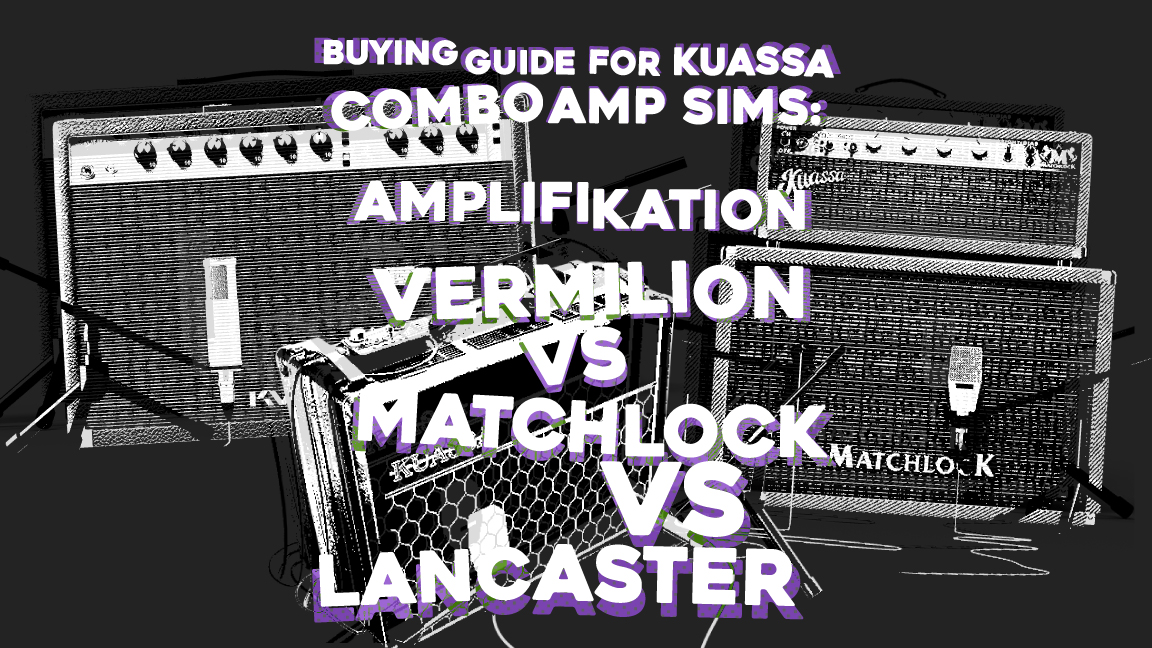
This article explores the different features and benefits of Kuassa’s combo amp sims, specifically Amplifikation Vermilion, Amplifikation Matchlock, and Amplifikation Lancaster. Each amp sim is discussed in detail, including their unique traits and the types of guitarists they are best suited for. The article also explains the 3rd generation amp engine used in these sims, which provides a natural, dynamic sound while keeping CPU usage low. The original amps that each sim is modeled on are also discussed, providing insight into their history and characteristics. Finally, the article concludes with a reminder that these guides should be taken as a starting point, and that guitarists should try each sim for themselves to find the one that best suits their playing style and preferences.
When it comes to recording guitars, amp simulations have become increasingly popular. They offer a lot of advantages over traditional recording setups, including the ability to record at any volume level and the ability to change amplifier settings and microphones after the recording is complete. When it comes to amp simulators, Kuassa’s Amplifikation series is one of the top choices for many guitarists. In this article, we will compare three of Kuassa’s combo amp simulators – Amplifikation Vermilion, Amplifikation Matchlock, and Amplifikation Lancaster – and explore their specific traits and which type of guitarists they are best suited for.
About 3rd generation amp engine:
Before we dive into the individual amps, it’s important to mention that Kuassa’s third-generation amp engine was initially introduced in Amplifikation Caliburn. This tube simulation engine guarantees a satisfying, dynamic, natural-sounding, and realistic amp recording experience for guitarists. The third-generation tube simulation engine offers the perfect blend between accurate, high-quality amp modelling while keeping the CPU usage as acceptable as possible for today’s modern computers.
Amplifikation Vermilion is Kuassa’s all-time best-selling product. Unlike the other two amps in this guide, Vermilion is not modeling a specific type of amp but is instead designed to sound immediate and great. It takes inspiration from vintage and obscure combo amps that were not well-known but had interesting sounds. It includes three amp models:
- Amp A: This model is based on the old rectifier design found on early Mesa Boogie or Fender Bassman amps. It has a warm and full-bodied sound with plenty of sustain and low-end.
- Amp B: This model is based on the design commonly found on older Vox amps, but not the AC series. It has a bright and chimey sound with a mid-range honk that cuts through a mix.
- Amp C: This model is similar to the lower wattage Jazz Chorusb amps. It has a clean and transparent sound that works well for jangly chords and arpeggios.
Amplifikation Vermilion is more of an all-around jangly machine but is also great for filling the gap between Matchlock or Lancaster. It is also the most affordable option compared to the other two amps. Vermilion is unique in that it includes a built-in tremolo and spring reverb. If you use Vermilion inside Amplifikation 360, it will break apart into three amps and Vermilion Tremolo and Vermilion Spring Reverb. This makes Vermilion a suitable choice for rockabilly, surf-rock, country, and jazz.
Amplifikation Matchlock is Kuassa’s best-selling amp sim of the past three years. It is powered by the 3rd generation amp engine and is praised by users for its exceptional responsive feel and dynamics.
The Matchlock is modeled after some of Fender’s most iconic amps, including the 65 Super Reverb, 65 Twin Reverb, and Custom Vibrolux Reverb. The Fender clean tone is often described as ‘scooped,’ as it is a little more lacking in the mid-frequencies than other amps. This gives the amps their signature bell-like, glassy top end and warm powerful lows. Fender amps are more famous for their clean sound, clarity, and versatility.
The Matchlock is perfect for guitarists who love to fiddle around with effect pedals. It is often called a “pedal palette” as it is the perfect companion for tone building mastery via effect pedals. Guitarists who love to experiment with effect pedals will surely love these amps.
Fender amps are known for their wide frequency range and cleaner-to-drive gain stage, making them ideal for big cleans. They are often used in genres such as shoegaze, ampli rhythm, blues, country, and American indie rock. Notable artists who have used Fender amps include Jimi Hendrix, Eric Clapton, The Edge of U2, and Johnny Marr of The Smiths.
Amplifikation Lancaster:
Amplifikation Lancaster is another 3rd generation amp engine from Kuassa, and it models a specific type of amp: the Vox AC30. The Vox AC30 is most famous for its 60s British Invasion sound, which can be heard on some of the most iconic pop and rock songs of all time. The AC30 has two channels – “normal” and “brilliant” – and comes in both top-boost and non-top-boost versions. Amplifikation Lancaster models three different Vox AC30 amps from three different decades:
- Lancaster A: Late 2000s AC30. This model breaks up and overdrives early, giving it a raw and raucous sound.
- Lancaster B: 1990s Limited Edition AC30. This model is fat and slightly compressed, with a thick sound that works well with overdrive or distortion.
- Lancaster C: Modified 1970s AC30. This model has a cleaner sound with huge headroom, and is instantly recognizable for its loud jangly tone.
One of the unique features of Amplifikation Lancaster is the parallel signal path from the normal and top boost channels. This gives the amp more mojo and adds to the tone sought after by many guitarists. A treble booster pedal FX is also included, giving the plugin a total modern incarnation of the original hardware setup.
The Vox and Lancaster amps are well-suited for Midwest emo or math-rock playing styles that require tone clarity. They are also popular among dream-pop artists such as My Bloody Valentine or Slowdive. Notable artists who have used these amps include Slowdive, Blur, Ride, John Frusciante, Muse, Dave Grohl, Slash, and Kevin Parker of Tame Impala.
Conclusion
Kuassa’s Amplifikation series offers a wide range of options for guitarists looking to achieve their desired sound. Each amp sim has its unique traits that cater to different genres, playing styles, and preferences. Amplifikation Vermilion is a versatile and affordable option with built-in tremolo and spring reverb, suitable for rockabilly, surf-rock, country, and jazz. Amplifikation Matchlock, on the other hand, is praised for its big cleans and nice breakups, perfect for guitarists who love to experiment with effect pedals. It is also well-suited for blues, jazz, country, and American indie rock. Finally, Amplifikation Lancaster with its parallel signal path and treble booster pedal offers the desired mojo from the tone sought after by many guitarists who needs tonal clarity, catering to Midwest emo, math-rock, and dream-pop artists. In conclusion, choosing between Amplifikation Vermilion, Amplifikation Matchlock, and Amplifikation Lancaster ultimately comes down to personal preference and playing style. Amplifikation Vermilion is a versatile all-rounder, Amplifikation Matchlock excels at working with pedals and achieving classic Fender tones, and Amplifikation Lancaster offers a wide range of chimey, jangly, and overdriven tones inspired by the Vox AC30.
Regardless of your preferred playing style or genre. With all the distinctiveness mentioned above, it is no surprise that Kuassa’s Amplifikation series has become a favorite among guitarists worldwide. So, whether you are an experienced professional or a beginner, you can rest assured that Kuassa’s Amplifikation series will offer the perfect amp sim for your musical journey. It’s worth noting that these Kuassa combo amp sims are not limited to just the specific amp models they are based on. As with any amp simulator, they can be used creatively to achieve a wide range of tones and styles beyond their intended models.
But as mentioned earlier, these guides should be taken as a starting point, and it’s always best to try them out for yourself to see which one suits your playing style and tone preferences the best. With free trials available on Kuassa’s download page, there’s no excuse not to give them a try and see what they can do for your guitar tone.


